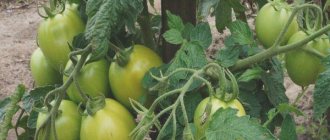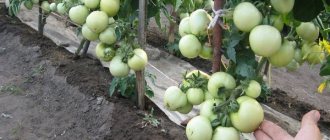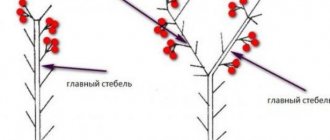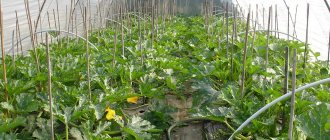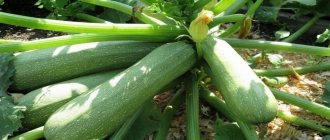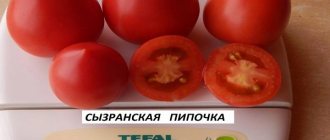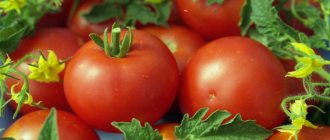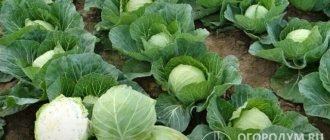The Dubok tomato enjoys the well-deserved love of gardeners and farmers. It is one of the best in the low-growing group - it is distinguished by productivity and ease of cultivation. Developed in Russia in the 21st century.
| Height | Landing location | Ripening time | Fruit color | Fruit size | Origin | Fruit shape |
| short | Greenhouse, Open ground | Early ripening | Reds | Average | Variety | Flat-round |
Tomato "Dubok": description of the variety
| Variety name | Oak |
| general description | Early ripening, determinate variety of tomatoes |
| Originator | Russia |
| Ripening period | 85-105 days |
| Form | Round, slightly flattened |
| Color | Red |
| Average weight of tomatoes | 50-100 grams |
| Application | Universal |
| Productivity of the variety | 6 kg per sq. meters |
| Features of cultivation | Standard agricultural technology |
| Disease resistance | Resistant to major tomato diseases |
The “Dubok” tomato variety is an early ripening variety, since from planting the seeds to the appearance of ripe fruits, it takes from 85 to 105 days.
The height of its determinate bushes, which are not standard, is 40-60 centimeters. They are compact and weakly branched. You can read about indeterminate varieties in this article. These tomatoes are intended for growing in open ground, but they are also grown in greenhouses, greenhouses, under film and even indoors. What is important about the characteristics of Dubok tomatoes is that they are extremely resistant to late blight, as well as other diseases.
This variety is not a hybrid and does not have any F1 hybrids of the same name.
The first inflorescence on these plants usually forms above the sixth or seventh leaf, and all the rest - through one leaf. The main stem has five or six inflorescences, and each cluster bears five or six fruits. About 6 kilograms of tomatoes are usually harvested from one square meter of land.
You can see the yields of other varieties in the table below:
| Variety name | Productivity |
| Oak | 6 kg per square meter |
| Kate | 15 kg per square meter |
| Nastenka | 10-12 kg per square meter |
| Crystal | 9.5-12 kg per square meter |
| Dubrava | 2 kg per bush |
| Red Arrow | 27 kg per square meter |
| Golden Jubilee | 15-20 kg per square meter |
| Verlioka | 5 kg per square meter |
| Diva | 8 kg per bush |
| Explosion | 3 kg per square meter |
| Golden heart | 7 kg per square meter |
IMPORTANT! When growing Dubok tomatoes indoors, it is necessary to carry out artificial pollination of flowers.
The most preferred predecessors for Dubok tomatoes are lettuce, carrots, cabbage, cucumber, onion and legumes.
Outdoor care
Dubrava tomatoes are unpretentious; even an inexperienced gardener can safely take on their cultivation. The agricultural technology of the variety is very simple, but it has some nuances.
Latest entries Indoor plants that can bloom into trouble Why is it dangerous to plant “mother-in-law’s tongue” on your windowsill Folk ways to acidify the soil and thereby increase its fertility
Watering and weeding
The variety does not need to be watered frequently, but you will have to monitor the soil moisture to prevent severe drying out in the area of the root system. Unlike other varieties, Dubrava can even withstand waterlogging of the soil. But still, it’s not worth the risk; the soil under the bush should be in a moderately moist state, which mulch will help maintain. The next day after watering, light loosening should be done to maintain normal access of oxygen to the roots.
Dubrava tomatoes prefer moderately moist soil
During the growing season, it is necessary to carry out at least 3 weedings, which will free the rows from weeds. In addition, clean soil is the key to plant health.
In clean beds and the harvest pleases
Top dressing
Frequent feeding can provoke the growth of green mass and reduce the ability to form ovaries. Therefore, you should refrain from applying excessive nitrogen.
- The first feeding is carried out 2 weeks after transplanting into the ground. To do this, add 25 g of superphosphate, 5 g of urea and 6 - 10 g of potassium salt per 1 m².
- When fruits begin to set, treat the plant with organic matter. One plant uses 0.8 liters of mullein solution or bird droppings. You can use wood ash - 100 g per 1 m².
What signs can be used to determine a lack of microelements - table
| Microelement | Symptom |
| Nitrogen | The leaves become small, chlorotic, the veins acquire a light red tint. |
| Zinc and magnesium | Gray-bronze spots appear on the leaf plate |
| Iron | The foliage turns yellow with a whitish tint. |
| Potassium | The edges of the leaf blade curl and turn yellow-brown |
| Phosphorus | Tomatoes are stunted and wither, necrotic spots appear on the leaves |
Tomato leaves will tell you which microelements the crop lacks
Garter and shaping
The peculiarity of the Dubrava variety in not forming stepsons will save the gardener from unnecessary labor. To increase productivity, the bush is formed from 3 – 4 shoots.
The low stature allows the variety to be grown without trellises or supports. But still, when the plant begins to bear fruit, it is better to tie it up so that the clusters with the filling fruits do not break.
Dubrava tomatoes are low-growing, but during the ripening of the crop it is better to tie the clusters with fruits
Advantages and disadvantages
Dubok tomatoes have the following advantages:
- disease resistance;
- unpretentiousness;
- frost resistance;
- simultaneous ripening of fruits;
- excellent transportability and keeping quality of tomatoes;
- excellent taste of fruits and versatility in their use.
Dubok tomatoes have virtually no flaws, which is why they are valued by vegetable growers.
Characteristics
The fruits of Dubok tomatoes are characterized by a rounded-flattened shape, medium size and red color. Their fleshy pulp has a pleasant rich taste with a slight sourness. These tomatoes have a small number of chambers and an average level of dry matter.
Their weight can range from 50 to 110 grams. Dubok tomatoes are great for transportation and long-term storage. Tomatoes "Dubok" are universal in use. They are used for whole-fruit canning, fresh consumption and processing.
You can compare the weight of the fruits of the Dubok variety with others in the table below:
| Variety name | Fruit weight (grams) |
| Oak | 50-100 |
| Broody | 90-150 |
| Andromeda | 70-300 |
| Pink Lady | 230-280 |
| Gulliver | 200-800 |
| Banana red | 70 |
| Nastenka | 150-200 |
| Olya-la | 150-180 |
| Dubrava | 60-105 |
| Countryman | 60-80 |
| Golden Jubilee | 150-200 |
How to grow tomatoes
Before planting seedlings in the ground, the soil on the site must be dug up and all weeds with roots must be removed. Be sure to apply organic and mineral fertilizers. Seedlings are planted in the beds when the ground has warmed to a depth of 15 cm.
Both sandy and loamy soil are suitable for tomatoes, into which nitrogen and potassium fertilizers are applied in the spring. The rules of crop rotation will help you choose the right area for tomatoes: it is recommended to plant them in beds where zucchini, onions, cucumbers, carrots, cabbage, and herbs previously grew. The place where representatives of the nightshade family previously grew is not suitable.
Hardened seedlings are transplanted into the ground, 3-4 bushes per 1 square meter. m. They loosen, weed and hill up every 2 weeks. For the first time after transplantation, it is recommended to protect the plant from sunlight, for example, with burdock leaves. Water the crop at the root and as needed.
Compliance with the following rules for planting tomatoes in the ground will help young plants quickly take root in outdoor conditions, which will ensure successful further growth and development:
- Water the pre-made holes with a manganese solution to disinfect the soil and further protect the fruits from infections.
- Plant the crop so that the first pair of leaves rises 2-3 cm above the ground. This will allow the root system to grow, receiving the required amount of fertilizer and oxygen.
- For the first 8-10 days, seedlings do not need watering.
- If necessary, shade the seedlings from the scorching sun.
- Start forming bushes only when new leaves appear, cutting off excess shoots and leaving 2 or 3 stems. This has a good effect on the fruiting of the crop.
If you want to get the harvest early, the bushes are pinched and the plant is formed into one stem. When forming a bush into 2 stems, the stepsons are removed from the three lower axils, when forming into 3 stems - from the two lower ones.
A prerequisite at the time of pollination is to maintain the temperature no higher than 25°C, otherwise pollination will not occur. It is necessary to be vigilant from the beginning to mid-May. In unfavorable conditions, use film shelters.
The crop does not need gartering, as the variety is low-growing. But tied bushes have their own advantages, the main one being that vegetables do not touch the ground and do not suffer from rot. At the same time, the integrity of the bush is not compromised: it does not break from its own weight.
When breeding low-growing tomatoes, nitrogen-containing fertilizers are applied once during fruit formation. Phosphorus and potassium are needed by the crop throughout the growing season. They are fed once every 2 weeks.
Diseases and pests
The average resistance of the plant to diseases indicates the need for regular preventive measures.
These include chemical treatment, mulching, and drip irrigation. For prevention, systemic-contact fungicides are used: Ditan M-45, Quadris 250. The frequency of preventive treatment is once every 20 days. When a crop is damaged by late blight, both chemical and traditional methods can be used to save the plant. Chemical treatments include treatment with Furacilin, and traditional treatments include soda or vinegar. Furacilin solution is prepared simply: 10 tablets per 10 liters of water. Spray before the flowers appear, at the first ovaries, at the first fruits. Spray with soda solution every week, dissolving 1 tablespoon of soda in half a bucket of water.
Mulching and fragrant herbs protect against insects living underground. The main land pest is the mole cricket. Moving underground, it damages the root system, as a result of which the seedlings die. Chopped cloves of garlic and fish heads also work well against mole crickets if you bury them in the beds.
Treatment with insecticides 1 month before fruiting will protect the plant from tomato mites. Among other things, for prevention purposes it is necessary to regularly inspect the bushes for the presence of pests from the insect world.
If tomatoes are planted in a greenhouse, do not forget to ventilate it regularly.
Features of cultivation
“Dubok” tomatoes are usually grown using the seedling method. Sowing seeds must be done in the first month of spring.
REFERENCE. Before sowing, the seeds must be treated with a solution of potassium permanganate and then washed with running water. Growth stimulants can be used.
If the air temperature in the room where the containers with seedlings are located is maintained at 18-20 degrees Celsius, then after 5-7 days you will be able to admire the first shoots. When the seedlings acquire two full-fledged leaves, they will need to be picked.
During the growth period, seedlings should be fed twice with complex fertilizers, and this should also be done during picking. A week before planting in the soil, seedlings should begin to be hardened off.
It should be added to the characteristics of “Dubok” tomatoes that the age of seedlings when planted in the ground should be from 55 to 65 days. Typically, planting occurs in April or May, when the likelihood of nighttime temperature drops completely disappears.
REFERENCE. The distance between bushes should be 40 centimeters, and between rows - 60 centimeters.
Tomatoes of this variety are suitable for growing in any region of Russia. It is advisable to form the bush into two stems. As for pinching, it is not a mandatory procedure, but it is still recommended. The same goes for tying.
It is very important to choose the right soil, both for planting seedlings and for adult plants in the greenhouse. An article about types of soil for tomatoes will help you figure this out.
Watering Dubok tomatoes should be done after sunset. They do not require abundant watering, but the soil should not be allowed to dry out. Mulching will help retain moisture and prevent weed growth. To increase productivity, Dubok tomatoes must be regularly fed with fertilizers.
To prepare the fertilizer, you need to mix 50 grams of superphosphate and 250 grams of wood ash, as well as one fifth of manure, in a bucket of clean water. This fertilizer needs to be applied once every twenty days.
Read more about how to fertilize tomatoes correctly and with what:
- Organic and mineral fertilizers.
- TOP best.
- Yeast, iodine, hydrogen peroxide, ammonia, ash, boric acid.
- Fertilizers for seedlings and foliar.
We must not forget about removing weeds and loosening the soil, as well as hilling the plants.
Further care
In order for the Dubrava tomato variety to meet all expectations and produce a high-quality harvest, you must follow all the rules for caring for the crop.
Watering and fertilizing mode
Water the Dubrava tomato bushes 1-2 times a week with warm water under each bush directly onto the surface of the root system. In rainy weather, avoid the procedure; excess moisture can provoke the development of late blight.
The culture is responsive to fertilizing. It is recommended to fertilize once every 20 days using the following nutritional composition:
- 250 g wood ash;
- 50 g superphosphate;
- 1/5 of the total volume of manure;
- 10 liters of water.
Also, to speed up growth, feed the plants with nitrogen fertilizers.
Weeding beds
One of the measures for caring for the Dubrava tomato variety is loosening the beds, which must be done after each watering. The first time you should loosen the soil deep enough to 10–12 cm. This will create air permeability of the soil and comfortable conditions for warming up and enriching with oxygen, which is necessary for the roots of the plant, especially at the initial stage of the growing season. Subsequent loosening should be carried out to a depth of 5 cm. It is also necessary to prevent soil compaction in a timely manner, after rains and during drought.
Garter and shaping
The oak grove does not need to be tied up, since the crop is a low-growing variety. But by following this procedure, you can simplify care, get clean fruits, since they will not touch the ground, and the trunk will not break as it grows and under the weight of the vegetables. When positioned vertically, the tomato bush is better illuminated and the crop ripens faster.
Disease and pest control measures
The average resistance of Dubrava tomatoes to diseases requires a full range of protective measures. For prevention, it is necessary to treat the bushes with fungicides once every 20 days, as well as mulch and drip watering.
At the first symptoms of late blight, you can resort to chemical, as well as folk methods, using soda or vinegar. Among the harmful insects, the mole cricket is a serious danger to the crop. Since, moving under the ground, it damages the roots, which leads to the death of seedlings. Insecticides will help in the fight against it.
Diseases and pests
This type of tomato is practically not susceptible to disease, and it can be protected from pests with the help of insecticidal preparations. However, information about major diseases may be useful to you. Read all about:
- Alternaria, fusarium, verticillium.
- Late blight, protection against it and varieties that do not suffer from late blight.
- Diseases of tomatoes in greenhouses and measures to combat them.
Useful video
See a brief description of the Dubok tomato and what the fruits look like in the video below:
In the table below you will find links to tomato varieties with different ripening periods:
| Mid-season | Mid-late | Late ripening |
| Gina | Abakan pink | Bobcat |
| Ox ears | French grape | Russian size |
| Roma f1 | Yellow banana | King of Kings |
| Black Prince | Titanium | Long Keeper |
| Lorraine beauty | Slot f1 | Grandma's gift |
| Stellate sturgeon | Volgogradsky 5 95 | Podsinsky miracle |
| Intuition | Krasnobay f1 | Brown sugar |
Technology of planting seedlings
Trays with seeds in moistened soil are wrapped in plastic bags and placed in a warm place. Shoots should appear in about a week, after which they are exposed to light. After another one or two weeks, when the plants have two adult leaves, a pick is made.
Using a teaspoon, the seedlings are removed from the common tray, keeping a lump of earth on the root system, and placed in separate larger containers (cassettes). As the seedlings grow, when the roots become crowded, this procedure (called transshipment) can be repeated.
In this case, the stem with the root collar can be buried down to the lower leaves. As with all nightshades, this will lead to additional development of the root system.
